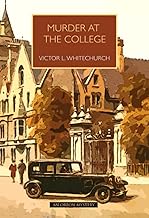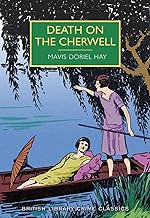Death Among the Dons
 A couple of years ago, I gave a talk at Alibis in the Archives at the Gladstone Library and promised to post it on my blog. What with a house move and other distractions, it slipped my mind. But here is a edited version of it – or some of it. It is rather long, so I am splitting it into two parts. The first deals with Oxbridge Colleges and here it is.
A couple of years ago, I gave a talk at Alibis in the Archives at the Gladstone Library and promised to post it on my blog. What with a house move and other distractions, it slipped my mind. But here is a edited version of it – or some of it. It is rather long, so I am splitting it into two parts. The first deals with Oxbridge Colleges and here it is.
It wasn’t until I started preparing my talk that I realised quite how many crime novels have been set in academic institutions. Yet the appeal is obvious. A closed circle setting allows the writer to bring together a group of people and set them at each other’s throat. University and colleges are stuffed to the gunnels with highly intelligent, highly competitive, highly devious people. They are hotbeds of neurotic over-achievement, back-biting, elitism and intellectual snobbery. I should know: I used to work in one. As an ex-colleague remarked on hearing that I had written a crime novel set in a fictional Cambridge college: ‘many crimes go unrecorded in Cambridge.’ Though perhaps not many actual murders, unless you count character assassination.
As Martin Edwards points out in The Story of Classic Crime in 100 Books, many of the male crime writers of the 1930s had been educated at public school and had gone on to Oxford or Cambridge. Some of them – J. C. Masterman, Glyn Daniel, Michael Innes – were actually dons. They were writing about what they knew. Michael Innes set his first novel, Death in the President’s Lodging (1936) , in a fictitious Oxford college, St Anthony’s. Other fictional Golden Age colleges include St Thomas’s in J.C. Masterman’s An Oxford Tragedy (1933) and Beaufort College in Dermot Morragh’s The Mummy Case (1933). Victor Whitchurch’s Murder at the College (1932} is based on a thinly disguised Oxford. Later there was Gervase Fen, lecturer in English as St Christopher’s college: the eponymous moving toy shop of Edmund Crispin’s 1946 novel was in the Iffley Road. And Inspector Morse. There are more fictional Oxford Colleges than there are real ones.
The college setting lent itself especially to the requirements of Golden Age crime fiction. They were closed  communities to a much greater extent than they are today with rules about the hours at which undergraduates could stay out at night, only one official way in and that guarded by porters, so lots of potential for plot complications concerning keys and alibis. And what masculine places these were, quasi monastic really, with unmarried dons living in college, and even married men often dining in hall. The tensions inherent in this situation helps to power the plot in several GA college crime novels, most notably J. C. Masterman’s An Oxford Tragedy. Glyn Daniel’s The Cambridge Murders is especially interesting in this regard. Daniel’s amateur sleuth is Sir Richard Cherrington, a 60 year old archaeologist. Although single he has certainly not led a celibate life, and is more of a man of the world than his colleagues. The murdered man is the middle-aged Dean of the College married to a much younger and very attractive woman. He sleeps in college two or three nights and that’s not regarded as unusual, in fact it’s expected of him. His wife is left alone at home and it’s hardly surprising that the marriage founders and she decides to leave him for another man. When the Dean is found shot dead, both she and her lover come under suspicion. Sir Richard muses on the damage done by the Cambridge way of life. ‘Sir Richard gazed around Fothergill’s rooms. They were typical of a young hard-working Fellow with few interests but his work. Yes, this man certainly needed a woman to humanize him and turn him into a sensible human being, who earned his living by scholarship and teaching rather than a scholar and academic teacher who in the intervals of work lived in a brief and fitful way. That was the trouble with the university, and that was the justification, in part, for the world’s condemnation of dons as eccentric and unworldly.’
communities to a much greater extent than they are today with rules about the hours at which undergraduates could stay out at night, only one official way in and that guarded by porters, so lots of potential for plot complications concerning keys and alibis. And what masculine places these were, quasi monastic really, with unmarried dons living in college, and even married men often dining in hall. The tensions inherent in this situation helps to power the plot in several GA college crime novels, most notably J. C. Masterman’s An Oxford Tragedy. Glyn Daniel’s The Cambridge Murders is especially interesting in this regard. Daniel’s amateur sleuth is Sir Richard Cherrington, a 60 year old archaeologist. Although single he has certainly not led a celibate life, and is more of a man of the world than his colleagues. The murdered man is the middle-aged Dean of the College married to a much younger and very attractive woman. He sleeps in college two or three nights and that’s not regarded as unusual, in fact it’s expected of him. His wife is left alone at home and it’s hardly surprising that the marriage founders and she decides to leave him for another man. When the Dean is found shot dead, both she and her lover come under suspicion. Sir Richard muses on the damage done by the Cambridge way of life. ‘Sir Richard gazed around Fothergill’s rooms. They were typical of a young hard-working Fellow with few interests but his work. Yes, this man certainly needed a woman to humanize him and turn him into a sensible human being, who earned his living by scholarship and teaching rather than a scholar and academic teacher who in the intervals of work lived in a brief and fitful way. That was the trouble with the university, and that was the justification, in part, for the world’s condemnation of dons as eccentric and unworldly.’
Sir Richard wasn’t wrong. Death on May Morning by Max Dalman (1938) begins with the famous celebration of dawn on the top of Magdalene tower, when the undergraduate son of a South American dictator is killed by a rifle shot. Inspector Osbourne and his sidekick wonder if it is the work of a homicidal maniac. The sidekick says, ‘You seem to have ruled out the dons. Now, I would have thought some of them were mad enough’. Inspector Osbourne agrees: ‘Given several hundred men devoted – or at any rate getting their living from – intellectual pursuits, the possibility of a nervous breakdown can’t be ruled out.’
 The men didn’t have it all their own way even in Oxford. A woman’s college, Shrewsbury, features in Dorothy L. Sayers’s Gaudy Night(19350 and there’s Persephone College in Mavis Doriel Hay’s Death on the Cherwell (1935). Mavis Doriel Hay was a graduate of St Hilda’s which was pretty clearly the inspiration for Persephone. A group of undergraduates discover the body of the Bursar floating down the river in a punt and try to beat the police to the uncovering of the killer. Gaudy Night is altogether weightier. Dorothy L. Sawyers was a graduate of Somerville, the inspiration for Shrewsbury where Harriet Vane studied. When the college is plagued by a series of poison pen letters, she is asked to go and help. The Oxford setting is lovingly evoked and explores the question of what it is worth sacrificing for a life of scholarship.
The men didn’t have it all their own way even in Oxford. A woman’s college, Shrewsbury, features in Dorothy L. Sayers’s Gaudy Night(19350 and there’s Persephone College in Mavis Doriel Hay’s Death on the Cherwell (1935). Mavis Doriel Hay was a graduate of St Hilda’s which was pretty clearly the inspiration for Persephone. A group of undergraduates discover the body of the Bursar floating down the river in a punt and try to beat the police to the uncovering of the killer. Gaudy Night is altogether weightier. Dorothy L. Sawyers was a graduate of Somerville, the inspiration for Shrewsbury where Harriet Vane studied. When the college is plagued by a series of poison pen letters, she is asked to go and help. The Oxford setting is lovingly evoked and explores the question of what it is worth sacrificing for a life of scholarship.
More recently between 1993 and 2007 Jill Paton Walsh’s Cambridge novels, A Piece of Justice, The Wyndham Affair, Debts of Dishonour, and The Bad Quarto feature an amateur sleuth who is the college nurse at St Agatha’s College, an interesting variant. And then there is Ruth Dudley Edwards’s splendidly comic Matricide at St Martha’s (1995), which takes no prisoners in lampooning academic life. And of course there’s Colin Dexter. Inspector Morse went to Lonsdale College, and many other fictional colleges feature in the three TV series, Morse, Lewis and Endeavour, that sprang out of the novels: Wolsey, Carlyle, a women’s college, St Matilda’s, to name but a few.
Next time: Josephine Tey, P.D.James – and me.
4 Comments
Margot Kinberg
June 27, 2025This is really interesting, Christine! You’re absolutely right, too, about how perfect colleges and universities are as settings for a fictional murder. For all the reasons you laid out, they really do work well. And I’ve found that each college and university has its own culture, traditions, and so on, and that, to me, can add layers to a story. I look forward to your next post on your talk.
Christine Poulson
June 28, 2025Thanks, Margot! Yes, you’re right about different institutions having different cultures and the way that adds another layer. I do like an academic mystery – and there are still teachers and academics writing mysteries. We are evidence of that …
Moira@Clothes in Books
June 30, 2025You know what a joy this is to me! I do love an academic mystery, and have read some of the ones you mention. I will look forward to the second half….
Christine Poulson
June 30, 2025Yes, indeed! I could not say that I whole-heartedly recommend everything I read, but it was fun. I was rather disappointed by Death at the President’s Lodging, which I didn’t enjoy as much as when I first read it.